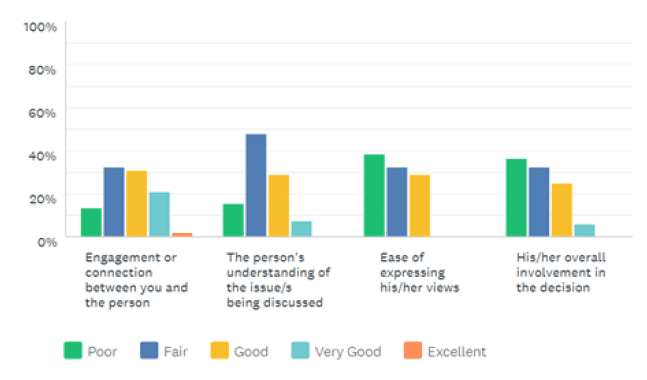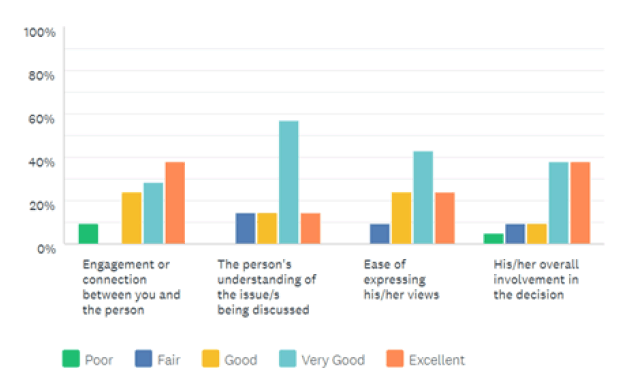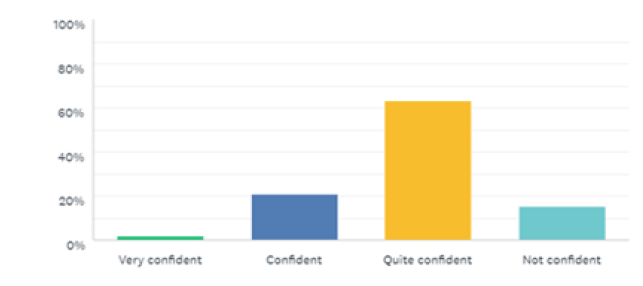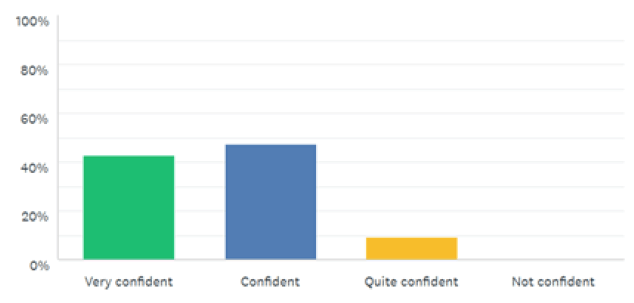Can Scotland be Brave – Incorporating UNCRC Article 12 in practice
This project investigated how well practitioners, understood and implemented the full obligations of Article 12 of the United Nations Convention on the Rights of the Child (‘UNCRC’).
Feedback on use of Talking Mats
What did the Practitioners say about using Talking Mats?
We asked practitioners to tell us about how they felt about having conversations with children and young people both with and without a TM as illustrated in Figures 6a and 6b below. We asked them to think about a child they are currently working with and rate the following when seeking their views.
1. Person's engagement
2. Person's understanding
3. Person's ability to express their views
4. Person's involvement
Pre- and Post-training survey results: -

Figure 6a Description
We asked practitioners to tell us about the quality of the conversations they have with children and young people.
13% felt engagement was poor, 33% said it was fair, 31% said it was good, 21% said it was very good and 2% said it was excellent
We asked about the child or young person’s understanding
15% said it was poor, 48% said it was fair, 29% said it was good, 8% said it was very good and 0% said it was excellent
We asked about how easily they felt the child or young person could express their view.
38% said poorly, 33% said fairly well and 29% said they felt the child or young person was good at expressing a view. 0% said very good or excellent.
We asked about how much they felt the CYP was involved in the overall decision.
37% felt the involvement was poor, 33% said it was fair, 25% said it was good and 5% said it was very good, 0% said excellent.

Figure 6b Description
9% said the engagement was poor, 0% said fair, 24% said good 29% said very good and 38% said excellent
We asked about the child or young person’s understanding:
0% said poor, 14% said fair, 14% said good, 57% said very good and 15% said excellent
We asked about how easily they felt the child or young person could express their view.
0% said poor, 9% said fair, 24% said good 43% said very good and 24% said excellent
We asked about how much they felt the CYP was involved in the overall decision.
4% said poor, 9% said fair, 9% said good 39% said very good and 39% excellent
The graphs below (Figures 7a and 7b) demonstrate improvement in all 4 indicators showing that the quality of the conversation improved when using a Talking Mat.

Figure 7a Description
2% very confident
21% confident
63% quite confident
15% not confident.

Figure 7b Description
43% very confident
47% confident
10% quite confident
0% not confident
Before training, only 23% of practitioners said they were confident or very confident that a CYP's view was reflected in the final decision. After training, 90% of practitioners were very confident or confident that their agreed actions genuinely reflected CYP views.
85% said that they think Talking Mats will be very valuable or extremely valuable in their future work.
What did the young people say about using Talking Mats?
Two methods for gathering the young peoples' views were used in the project:
1. After doing a mat the listener (adult facilitating) asked the young person how they felt about using a Talking Mat with 2 questions
a) What do I think about my Talking Mat?
b) What would I say to other people about doing a Talking Mat? (Appendix 5)
2. Young people were included in a focus group in the primary school context.
11 P1-P3 (aged 5-8 years) feedback gained through talking informally and drawing
16 P4-P7 (8-12 years) feedback gained through structured questions/discussion
Topic: My World
"It helped me think about things at home"
"I think it was pretty fun; It's about how you are feeling about stuff"
"Gives you a chance to talk to a youth worker"
18 young people gave feedback after using the topic set My World (age range 6-14 years).
17 of the 18 comments included the words good and fun. ‘It’s good. I would say it’s funny and fun.’ One young person said ‘it was boring as I could just talk to you anyway, but interesting because it’s different.’
Topic: All about Me
11 comments from young people were provided. 2/11 when asked what they thought about their mat said they didn’t know. 9/11 included the word good in their comments, ‘I think it’s a good mat. Yeah it’s good ‘cos you get to talk about things’
"I think it’s a good way for people to understand how you feel"
"It calms me down. It’s very helpful".
"It was nice to talk about things"
Topic: What I do
8 comments were gathered for this specific topic. All were positive ‘(The mat) …can help you through a difficult time’
"I think it went ok-it was fun and easy to describe my feelings because I don’t like talking"
Other people should do Talking Mats. It helps
It was nice to be able to talk about me without being interrupted
Focus Groups
Focus groups were held in the primary school. These took place a few weeks after the CYP had done their Talking Mats in school and the time delay could have affected the reliability of their feedback. Four small groups of between 5 and 10 children were included. In total 27 children were consulted.
- Groups 1 and 2. 11 P1-P3 (aged 5-8 years). Feedback gained through talking informally and drawing.
- Groups 3 and 4. 16 P4-P7 (aged 8-12 years). Feedback gained through structured questions/discussion.
Groups 1 and 2
9 out of the 11 said they would do a Talking Mat again, 2 weren’t sure.
I felt happy when I done the Talking Mat. Because I got to have a little bit of time with my teacher.
After I done my TM, I got to do a little job.
Groups 3 and 4
For the pupils aged 8-12 years a questionnaire was completed as a group activity (Appendix 6)
Outcomes:
- 9 of the 16 young people felt they could express everything they wanted to talk about. 2 comments: 'You wouldn't want people gossiping' and '[X] was scared to speak about everything'.
- 12 of the 16 weren't sure or were not confident that if they expressed a concern then something would change.
- 3 pupils reported they were not happy with where the Talking Mats conversation took place. The pupil below commented that she wasn't happy about the space: 'it was just outside the class'.
What might be a safe space for the adult could be viewed very differently by the CYP. 10/11 staff members were confident that views would be heard by someone with power to make decisions (within school), whereas only 4/16 pupils felt happy or very happy that something would change.
Contact
Email: Charles.laing@gov.scot
There is a problem
Thanks for your feedback